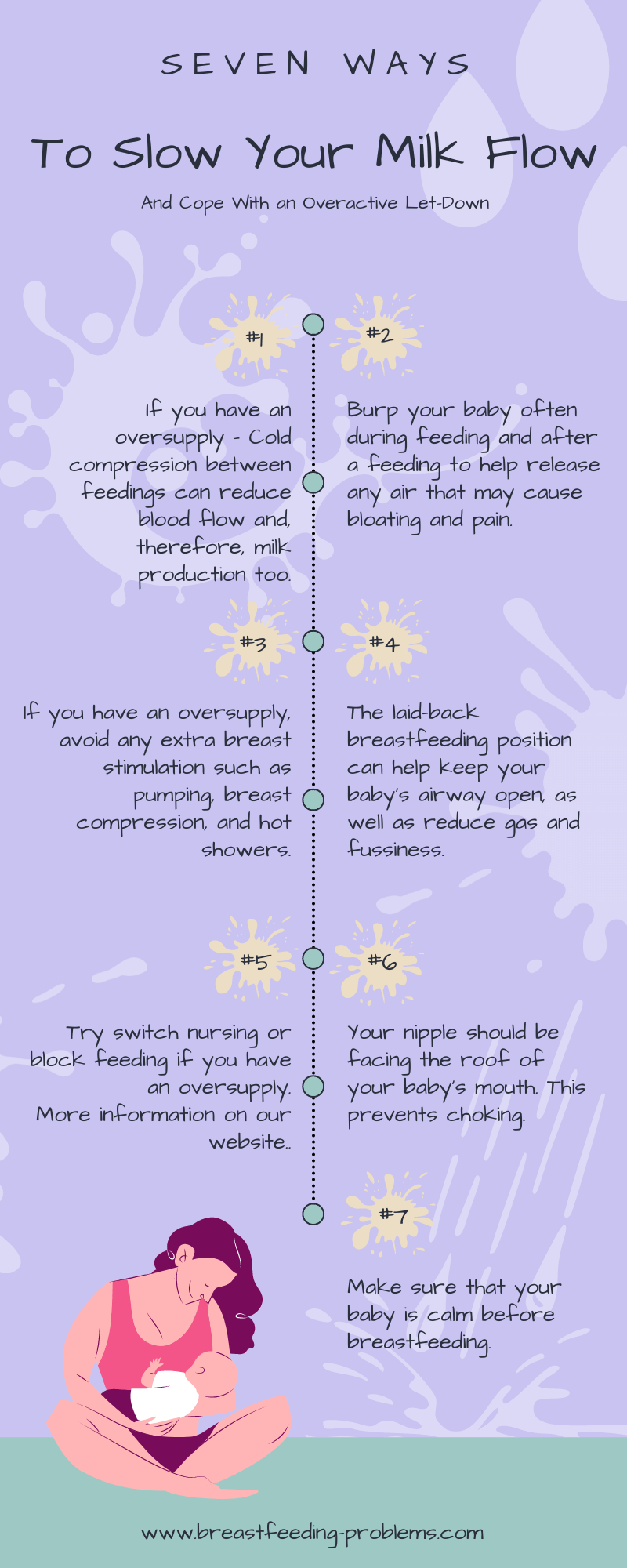Seven Ways to Slow Your Milk Flow & Cope With a Forceful Letdown
Your baby may struggle to stay on the breast when your milk flow is too forceful. This could also cause your baby to swallow large amounts of air while nursing, causing choking at the breast and excessive gassiness.

- Things you need to know
- Do I have an oversupply?
- The seven ways to slow your milk supply.
- Ways of coping with a fast flow of milk
- Switch nursing and block feeding.
What You Need to Know
Your baby may struggle to stay on the breast when your milk flow is too forceful; this could also cause your baby to swallow large amounts of air while nursing, leading to choking at the breast and excessive gassiness.
There are two options when it comes to an overactive let-down: try to help your baby cope with the fast flow of your milk and decrease your milk supply, although only if you have an oversupply. The signs of oversupply are discussed below.
During the first six weeks after birth, your milk supply is trying to regulate itself to meet your baby's needs. Most mothers have let-down issues and a rapidly increasing milk supply throughout this time. It would be best if you did not try to decrease your milk supply during the first six weeks. Give your body a chance to do its thing.
Not all mothers with an overactive let-down have hyperlactation issues. To see results, you will need patience and time to adjust.
So, How Do You Know if You Have an Oversupply?
The signs of oversupply
- Your baby has runny, explosive, mucousy, green poop.
- Your baby is experiencing colic symptoms (crying for long periods at a time)
- Your baby fusses during feeds. Usually bopping on and off of the breast.
- Your baby coughs while breastfeeding or chokes on your breast milk while feeding.
- Your baby is excessively gassy. Usually, you can see this when their tummy is hard and distended.
- Your baby spits up more frequently than most.
- Your baby may gain weight too quickly.
Seven Ways To Slow Your Milk Flow

Coping With a Fast Flow of Milk Explained
Let it Spray
When you feel a let-down, you can remove your little one from the breast and let the milk flow into a cloth. Put your baby back on the breast as soon as let-down has ceased.
The Latch
Ensure that your nipple faces the roof of your baby's mouth, not the back of their throat.
Air Intake
Burping your baby as often as possible during a feed will prevent bloating and discomfort.
A Calm Baby
If you breastfeed when your baby is relaxed, they will suck slowly, making the milk flow more manageable.
The Position
When you breastfeed, try to choose a breastfeeding position that will cause gravity to work against milk flow; this will prevent air intake and choking at the breast. Some good positions to choose from:
- The Biological nursing position is the most natural way to breastfeed with excellent support to prevent straining. It is the perfect position for skin-to-skin contact, which has its own advantages.
- The side-lying position will encourage the excess milk to dribble down the sides of your baby's mouth.
- You can utilize the Australian breastfeeding hold for older babies. This position is when the child sits up and faces mom.

When You Have an Oversupply, How Do You Slow Down an Overactive Let-down?
In addition to the top-mentioned coping mechanisms, you can do the following to help reduce the milk supply.
Switch Nursing
There is always the risk of a low milk supply, blocked ducts, and mastitis developing with block feeding (mentioned below). Therefore, there is a method that I would recommend before trying block feeding. It's called switch nursing.
How does switch nursing work?
A mother will switch sides more often than usual during a feeding. So, if you usually switch breasts after about 10 minutes of nursing, you can now switch after 5 minutes or sooner. You can also switch more often than just once during a feeding.
Switch nursing results in both breasts receiving stimulation and the message to decrease milk production because the breasts are not drained thoroughly. Unlike block feeding, you will be more comfortable, and the reduction in milk supply is gradual. You may notice that your little one is a little fussier than usual, but give your body some time to adjust.

The Tushbaby Hip Carrier
With its ergonomic design and comfortable waistband, Tushbaby provides optimal support for you and your baby. Say goodbye to shoulder and back pain from traditional carriers, as Tushbaby evenly distributes your baby's weight, relieving strain and promoting better posture.
Block Feeding
How does block feeding work?
- When you feed your baby during six hours, breastfeed on demand from only one breast. Alternate breasts every six hours.
- If the breast that has not been fed from becomes engorged, you can express just enough milk to feel comfortable. The less milk removed from the breast, the less milk produced.
- You can also use cool compresses to relieve any discomfort from the breast that has not been fed from, which will decrease blood flow and milk supply. Use the cold compress for one-half hour,, then remove for one hour,, and so forth.
- If block feeding has not reduced your supply within a week, you should seek out the help of a lactation consultant. Alternatively, opt for a Milkology breastfeeding course and equip yourself with the comprehensive knowledge necessary for a successful breastfeeding experience.
- The block feeding guidelines.
Remember, when you breastfeed less frequently, when you breastfeed less frequently, you should watch for blocked ducts, blebs, and mastitis.
Avoid Extra Stimulation
Pumping or hand expression should be done with caution and only when necessary, as these can stimulate milk production, which can be counterintuitive. Also, avoid breast compressions and hot showers while breastfeeding.
Conclusion
Do not block feed or try to reduce your milk supply if your baby is not gaining weight as they should.
If all else fails, you can try using herbs to decrease your milk supply. Herbs should be used under the guidance of a lactation consultant.
When does an overactive let-down get better?
Between 6 and 12 weeks, most mothers notice a drop in supply and a decrease in milk flow. During this, a mother's hormones change again, and the milk supply becomes more stable; this can also lead to frustration at the breast because the baby is accustomed to a faster milk flow. If you are struggling with a slow let-down, please see our page on increasing your milk let-down reflex.
Breastfeeding Let-down References
Header photo by __ drz __ on Unsplash
Block feeding dos and don'ts by Nancy Mohrbacher, IBCLC, FILCA
Nurturedchild.ca - breastfeeding challenges - oversupply and forceful let-down.
